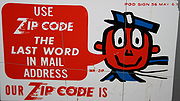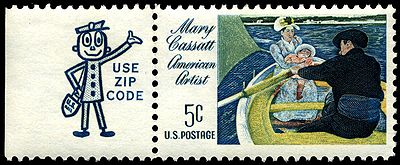
Mr. ZIP
Encyclopedia

United States Post Office Department
The Post Office Department was the name of the United States Postal Service when it was a Cabinet department. It was headed by the Postmaster General....
, and in the 1970s by its successor, the United States Postal Service
United States Postal Service
The United States Postal Service is an independent agency of the United States government responsible for providing postal service in the United States...
, to encourage the general public to include the ZIP code
ZIP Code
ZIP codes are a system of postal codes used by the United States Postal Service since 1963. The term ZIP, an acronym for Zone Improvement Plan, is properly written in capital letters and was chosen to suggest that the mail travels more efficiently, and therefore more quickly, when senders use the...
in all mailings.
Origins
The USPS has described the origin of Mr. ZIP as follows:Mr. ZIP was based on an original design by Howard Wilcox, son of a letter carrier and a member of the Cunningham and Walsh advertising agency, for use by a New York bank in a bank-by-mail campaign. Wilcox's design was a child-like sketch of a postman delivering a letter. The figure was used only a few times, then filed away. Later, AT&T acquired the design and made it available to the Post Office Department at no cost. ... Post Office Department artists retained the face but sharpened the limbs and torso and added a mail bag. The new figure, dubbed Mr. ZIP, was unveiled at a convention of postmasters in October 1962.
Post Office use

Mr. ZIP is a caricature of a mail carrier
Mail carrier
A mail carrier, mailman, postal carrier, postman, postwoman , postman/postwoman , letter carrier or postie is an employee of the post office or postal service, who delivers mail and parcel post to residences and businesses...
, wide-eyed and drawn with his letter bag trailing him in such a way as to imply his travelling at extreme speed, and sometimes holding on to his hat with his free hand. His hair was straight, but his skin was somewhat orange, making him non racially-identifiable.
His limbs were very thin, almost like those of a stick figure. He was used especially on posters promoting ZIP Code use. The character was largely phased out by the late 1970s, but the Post Office retained rights to the copyright
Copyright
Copyright is a legal concept, enacted by most governments, giving the creator of an original work exclusive rights to it, usually for a limited time...
ed figure, which has been revived on the Postal Service's ZIP Code lookup website
Website
A website, also written as Web site, web site, or simply site, is a collection of related web pages containing images, videos or other digital assets. A website is hosted on at least one web server, accessible via a network such as the Internet or a private local area network through an Internet...
.
Mr. ZIP appeared on the selvage
Selvage
The selvage or selvedge is the term for the self-finished edges of fabric. The selvages keep the fabric from unraveling or fraying. The selvages are a result of how the fabric is created...
(non-postally valid areas) of stamp panes (more commonly called "sheets") on many stamp issues, beginning with the 5 cent Sam Houston
Sam Houston
Samuel Houston, known as Sam Houston , was a 19th-century American statesman, politician, and soldier. He was born in Timber Ridge in the Shenandoah Valley of Virginia, of Scots-Irish descent. Houston became a key figure in the history of Texas and was elected as the first and third President of...
stamp issued January 10, 1964, although the 5¢ Battle of the Wilderness
Battle of the Wilderness
The Battle of the Wilderness, fought May 5–7, 1864, was the first battle of Lt. Gen. Ulysses S. Grant's 1864 Virginia Overland Campaign against Gen. Robert E. Lee and the Confederate Army of Northern Virginia. Both armies suffered heavy casualties, a harbinger of a bloody war of attrition by...
stamp of May 5, 1964, is sometimes listed as the "first" because it appears earlier in most stamp catalogs due to its inclusion in a five-issue Civil War
American Civil War
The American Civil War was a civil war fought in the United States of America. In response to the election of Abraham Lincoln as President of the United States, 11 southern slave states declared their secession from the United States and formed the Confederate States of America ; the other 25...
series. He also appeared on non-postally valid labels in, or on the covers of, stamp booklets. Stamp collectors sometimes collect the corner block of four stamps with the part of the selvage bearing Mr. ZIP; they are called "ZIP blocks". Mr. ZIP appeared in the blank selvage of United States stamps until January 1986.

